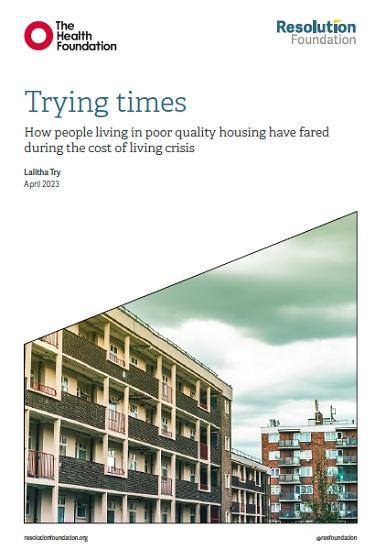Trying Times - How People Living In Poor Quality Housing Have Fared During The Cost Of Living Crisis
16th April 2023

Plenty of research has shown the important role housing plays on our living standards, attitudes and wider health and wellbeing. But less attention has been paid to the effect of housing quality on living standards.
In this report, we use data collected in March 2023 from an online YouGov survey (funded by The Health Foundation) of 10,122 adults aged 18+, to analyse the experience of the cost of living crisis by tenure, the incidence of poor quality housing, and the impact of poor quality housing on health and wellbeing.
According to our survey, 10 per cent of people live in poor quality housing (defined as living in homes that are not in a good state of repair, where heating, electrics or plumbing are not in good working order, and where damp is present), with people from more disadvantaged groups more likely to live in poor quality housing. And poor quality housing is also associated with poor health, which is still true after controlling for a range of income-related and demographic factors.
Key findings
Renters have been the most likely to have fallen behind on their housing costs over the last three months - with 15 per cent of social renters and 10 per cent of private renters in this position, compared to 4 per cent of mortgagors.
Although worries have fallen slightly over the past four months, a significant minority of people remain worried about their ability to afford their housing costs in the near future, with nearly 4 in 10 social and private renters worried about meeting their housing costs over the next three months.
10 per cent of people (6.5 million people) live in poor quality housing, defined in this report as living in homes that are not in a good state of repair, that have damp, and where the heating, electrics or plumbing are not working. People from traditionally more disadvantaged groups are more likely to be living in poor quality housing.
People living in poor quality housing are twice as likely to have poor general health than those who don't (22 per cent compared to 11 per cent). After controlling for income-related and demographic factors, the gap narrows but still exists: people living in poor quality housing were 4 percentage points more likely to say their general health is poor, and people living in poor quality housing were 6 percentage points more likely to have had poor mental health than those not living in poor quality housing.
Over half of people living in poor quality housing felt that the stress caused by rising living costs had worsened their health or that the money they had to spend on rising heating costs made their health worse, compared to 27 and 22 per cent respectively for those not living in poor quality housing; these differences also remain after controlling for demographic and income-related factors.
To work towards fixing the problem of poor quality housing, the Government must build more new affordable housing both for rent and purchase, better regulate housing conditions in the private sector, and improve conditions in social housing.
Pdf 14 Pages
To read the full research go HERE
Source - https://www.resolutionfoundation.org/publications/trying-times/
